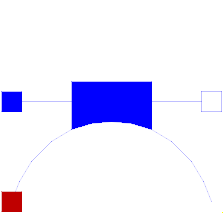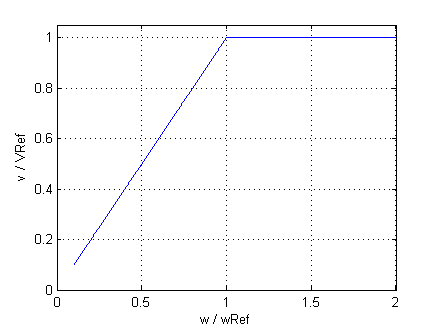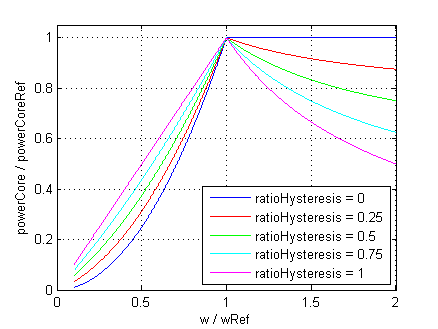 Package Modelica.Electrical.Machines.Losses.DCMachines
Package Modelica.Electrical.Machines.Losses.DCMachinesLoss models for DC machines
 Package Modelica.Electrical.Machines.Losses.DCMachines
Package Modelica.Electrical.Machines.Losses.DCMachinesThis package contains loss models used for DC machine models.
Extends from Modelica.Icons.VariantsPackage (Icon for package containing variants).
| Name | Description |
|---|---|
Brush | Model considering voltage drop of carbon brushes |
brushVoltageDrop | Voltage drop of carbon brushes |
Core | Model of core losses |
StrayLoad | Model of stray load losses dependent on current and speed |
 Model Modelica.Electrical.Machines.Losses.DCMachines.Brush
Model Modelica.Electrical.Machines.Losses.DCMachines.Brush
Model of voltage drop and losses of carbon brushes. For currents between -ILinear and ILinear
the voltage drop shows a linear behavior as depicted in Fig. 1.
For positive currents greater or equal than ILinear the voltage drop equals V.
For negative currents less or equal than -ILinear the voltage drop equals -V.
 |
| Fig. 1: Model of voltage drop of carbon brushes |
The voltage drop v is the total voltage drop of all series connected brushes.
If it is desired to neglect brush losses, set brushParameters.V = 0 (this is the default).
Extends from Modelica.Electrical.Analog.Interfaces.OnePort (Component with two electrical pins p and n and current i from p to n) and Modelica.Thermal.HeatTransfer.Interfaces.PartialElementaryConditionalHeatPortWithoutT (Partial model to include a conditional HeatPort in order to dissipate losses, used for textual modeling, i.e., for elementary models).
| Type | Name | Default | Description |
|---|---|---|---|
BrushParameters | brushParameters | Brush loss parameters | |
Boolean | useHeatPort | false | =true, if heatPort is enabled |
| Type | Name | Description |
|---|---|---|
PositivePin | p | Positive electrical pin |
NegativePin | n | Negative electrical pin |
HeatPort_a | heatPort | Optional port to which dissipated losses are transported in form of heat |
 Function Modelica.Electrical.Machines.Losses.DCMachines.brushVoltageDrop
Function Modelica.Electrical.Machines.Losses.DCMachines.brushVoltageDrop
Calculates the voltage drop of carbon brushes, according to Brush losses, e.g., used for initial equations.
Extends from Modelica.Icons.Function (Icon for functions).
| Type | Name | Description |
|---|---|---|
BrushParameters | brushParameters | Brush loss parameters |
Current | i | Actual current |
| Type | Name | Description |
|---|---|---|
Voltage | v | Voltage drop |
 Model Modelica.Electrical.Machines.Losses.DCMachines.StrayLoad
Model Modelica.Electrical.Machines.Losses.DCMachines.StrayLoad
The stray load loss torque is
tau = PRef/wRef * (i/IRef)^2 * (w/wRef)^power_w
where i is the current of the machine and w is the actual angular velocity.
The dependency of the stray load torque on the angular velocity is modeled by the exponent power_w.
The stray load losses are modeled such way that they do not cause a voltage drop in the electric circuit. Instead, the dissipated losses are considered through an equivalent braking torque at the shaft.
If it is desired to neglect stray load losses, set strayLoadParameters.PRef = 0 (this is the default).
Extends from Modelica.Electrical.Analog.Interfaces.OnePort (Component with two electrical pins p and n and current i from p to n), Modelica.Electrical.Machines.Interfaces.FlangeSupport (Shaft and support), and Modelica.Thermal.HeatTransfer.Interfaces.PartialElementaryConditionalHeatPortWithoutT (Partial model to include a conditional HeatPort in order to dissipate losses, used for textual modeling, i.e., for elementary models).
| Type | Name | Default | Description |
|---|---|---|---|
StrayLoadParameters | strayLoadParameters | Stray load loss parameters | |
Boolean | useHeatPort | false | =true, if heatPort is enabled |
| Type | Name | Description |
|---|---|---|
PositivePin | p | Positive electrical pin |
NegativePin | n | Negative electrical pin |
Flange_a | flange | Shaft end |
Flange_a | support | Housing and support |
HeatPort_a | heatPort | Optional port to which dissipated losses are transported in form of heat |
 Model Modelica.Electrical.Machines.Losses.DCMachines.Core
Model Modelica.Electrical.Machines.Losses.DCMachines.Core
Core losses can be separated into eddy current and hysteresis losses. The total core losses can thus be expressed as
p = PRef * (ratioHysteresis * (wRef / w) + 1 - ratioHysteresis) * (v / VRef)^2
where w is the actual angular velocity and v is the actual voltage. The term ratioHysteresis is the ratio
of the hysteresis losses with respect to the total core losses for reference inner voltage and reference angular velocity.
For the voltage and angular velocity range with respect to Fig. 1,
the dependency of total core losses on the parameter ratioHysteresis is depicted in Fig. 2.
 |
| Fig. 1: Voltage versus angular velocity |
 |
Fig. 2: Core losses versus angular velocity with parameter ratioHysteresis |
In the current implementation it is assumed that ratioHysteresis = 0. This parameter cannot be changed due to compatibility reasons.
Extends from Modelica.Electrical.Analog.Interfaces.OnePort (Component with two electrical pins p and n and current i from p to n) and Modelica.Thermal.HeatTransfer.Interfaces.PartialElementaryConditionalHeatPortWithoutT (Partial model to include a conditional HeatPort in order to dissipate losses, used for textual modeling, i.e., for elementary models).
| Type | Name | Default | Description |
|---|---|---|---|
CoreParameters | coreParameters | Armature core losses | |
Boolean | useHeatPort | false | =true, if heatPort is enabled |
| Type | Name | Default | Description |
|---|---|---|---|
AngularVelocity | w | Remagnetization angular velocity |
| Type | Name | Description |
|---|---|---|
PositivePin | p | Positive electrical pin |
NegativePin | n | Negative electrical pin |
HeatPort_a | heatPort | Optional port to which dissipated losses are transported in form of heat |